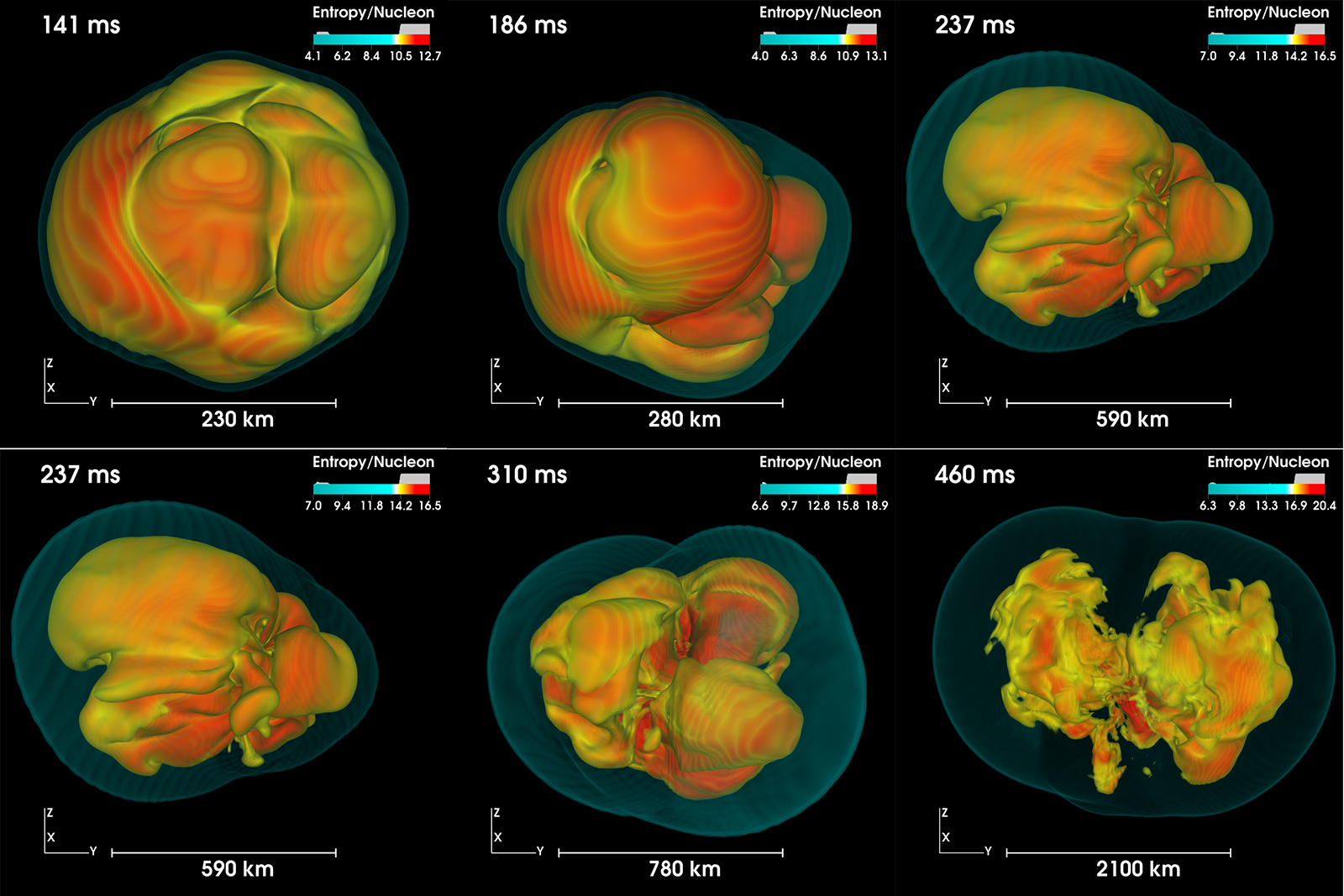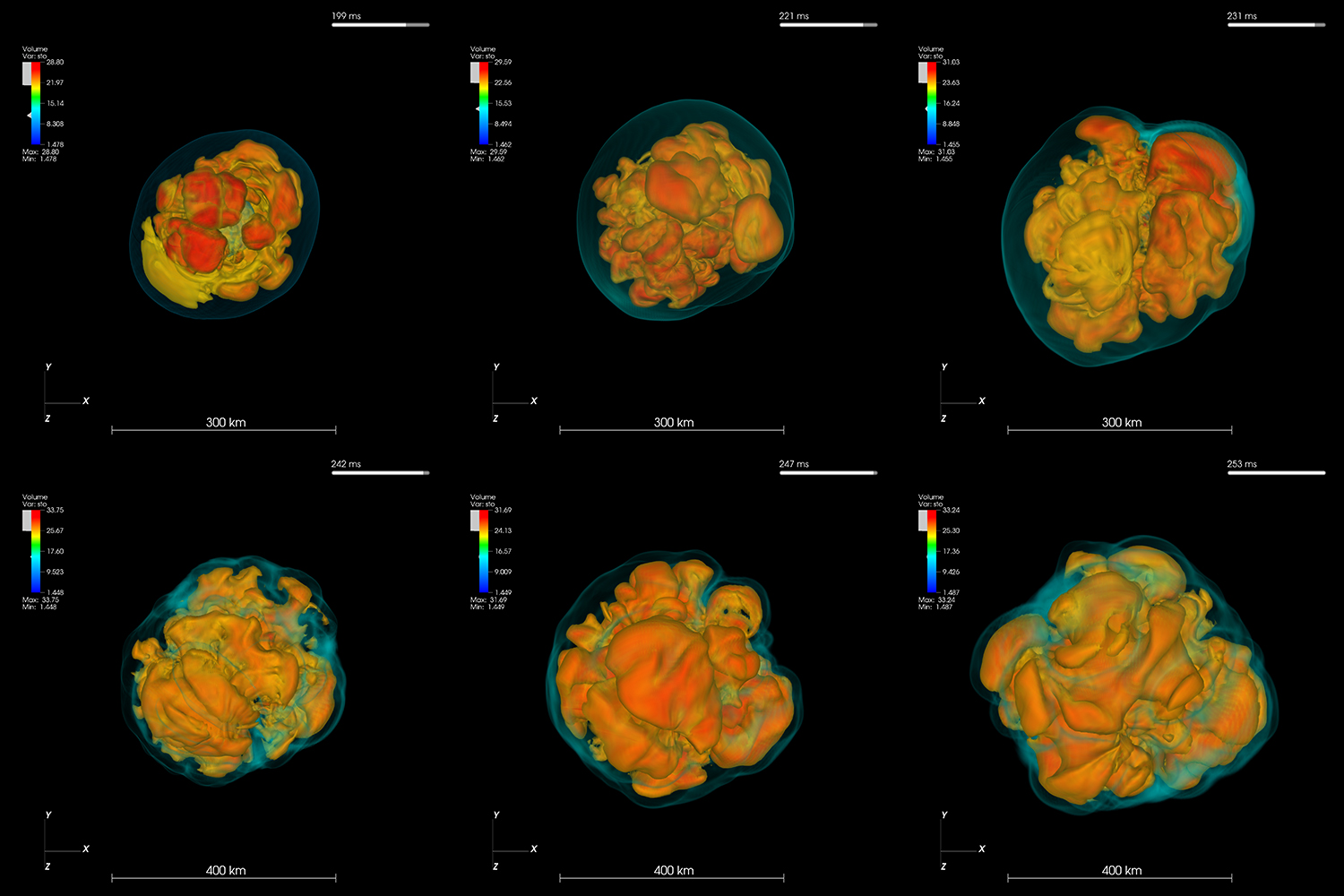ASTROPHYSICS
Longtime 3D Supernova Simulations for Establishing the Progenitor-Remnant Connection
Principal Investigator:
Hans-Thomas Janka
Affiliation:
Max Planck Institute for Astrophysics, Garching (Germany)
Local Project ID:
pr48de
HPC Platform used:
SuperMUC of LRZ
Date published:
Recently the first three-dimensional simulations have confirmed the long-standing hypothesis that the neutrino-driven mechanism, supported by violent hydrodynamic instabilities and turbulent mass flows, can explain supernova explosions of stars with more than 8−10 solar masses. Further consolidation of this mechanism and a deeper theoretical understanding of its functioning require the exploration of a broader variety of progenitor stars and of dependences on the initial conditions prior to iron-core collapse. In this Gauss project the influence of stellar rotation, perturbations in the convective oxygen-burning layer, and of large mass-infall rates due to high core compactness in very massive progenitor stars were explored.
Massive stars end their lives in a catastrophic gravitational collapse of their central cores, in the course of which huge amounts of energy are released that can power gigantic explosions known as supernovae. These fascinating events can shine as bright as a whole galaxy for weeks; they give birth to neutron stars or black holes, eject a major part of the heavy elements created since the Big Bang in stars and during their terminal explosions, and they are important players to determine the dynamical evolution of galaxies and the formation of many generations of stars therein. Understanding the physical processes that drive the supernova outbursts is of crucial importance not only for understanding the properties of these cosmic blasts but also for predicting the neutrino and gravitational-wave signals that will be measured in the case of a future event in our Milky Way Galaxy.
Owing to the growing power of modern massively parallel supercomputers, considerable progress towards unravelling the explosion mechanism could be achieved in recent years. Three-dimensional simulations of stellar core collapse with a detailed description of the crucial neutrino physics lend support to the so-called delayed neutrino-driven mechanism, in which neutrinos —radiated in huge numbers by the extremely hot matter of the collapsed stellar core— heat the plasma surrounding the newly formed neutron star. Because of the enormous complexity of the involved physics and the inaccessibility of the extreme conditions in supernova interiors to laboratory experiments, computer simulations are indispensable to decipher the processes that initiate and power the explosions. Three-dimensional models are needed because nonradial hydrodynamic mass motions (“instabilities”) and turbulent flows support the neutrino heating and impose large-scale asymmetries on the ejecta of the explosion. The necessity of global 3D modeling and the simultaneous need to resolve turbulent flows on relatively small scales, combined with the excessive computational demands connected to the high dimensionality of a detailed description of neutrino transport and interactions, set the requirements for the computing resources. One run of a full-scale supernova model with the standard choice of two degrees resolution in both angular directions of a polar grid requires about 50 million core hours on typically 16,000 cores of SuperMUC, corresponding to roughly 4.5 months of round-the-clock computing.
Strongly dependent on the availability of computing resources, the pool of simulations can therefore grow only gradually, despite the large mass-space of supernova progenitors that needs to be explored, ranging from about 8–9 solar masses on the low side to more than 100 solar masses on the high end. All of these progenitors differ in their radial structures prior to collapse: Lower-mass stars tend to have a relatively low core compactness, i.e., the steep density decline outside of their iron core favors relatively easy shock expansion and is expected to lead to faster explosions. In contrast, stars with higher core compactness (which typically tend to be also more massive) allow for less rapid shock expansion and are thought to be harder to explode. This general notion must be confronted with detailed explosion simulations. Moreover, besides the stellar density profile, also rotation of the progenitor core may play a role, and density and velocity perturbations in the convective burning shells of silicon, oxygen, and neon may have an influence on the beginning of the explosion.

Figure 1: Sequence of volume-rendered snapshots for the time evolution of an exploding 15 solar-mass star with rapid rotation. Colors represent entropy per nucleon. The neutrino-driven explosion is supported by a powerful spiral mode of the standing-accretion-shock instability (SASI), which drives shock expansion predominantly perpendicular to the rotation axis. The rotation axis coincides with the z-axis of the tripod in the lower left corner of each panel, and the supernova shock is visible as a bluish, transparent surface enveloping high-entropy bubbles of neutrino heated matter (red-orange-yellow surface). Time (information in the upper left corner of each panel) is measured in milliseconds after the formation of the supernova shock.
Copyright: Author and The American Astronomical SocietyThe current achievements reached by this Gauss project (ID pr74de) for 3D supernova explosion modeling with the Prometheus-Vertex supernova code can be summarized in four categories:
1. In addition to the successful neutrino-driven explosion of a previous low-mass progenitor of 9.6 solar masses, also a 9.0 solar-mass star was found to blow up by the neutrino-heating mechanism. However, the blast wave develops in a considerably different way, expanding more slowly and triggering an explosion with very pronounced global asymmetry.
2. In the oxygen shell of an 18 solar-mass progenitor a quadrupolar convective mode was found to develop on the way to the gravitational instability of the stellar core. The corresponding large-scale flow pattern leads to high-amplitude density perturbations of the matter falling into the supernova shock. This stirs the growth of vorticity and turbulence in the postshock layer, thus enabling the onset of the neutrino-driven explosion in this star.
3. Pre-collapse rotation can aid the explosion by fostering the growth of powerful spiral modes associated with the standing-accretion-shock instability (SASI). However, this helpful effect is strong enough only for initial spins that are several times faster than predicted for the far majority of stellar cores at the onset of collapse. Explosions supported by spiral-SASI activity exhibit an oblate shape with strongest expansion perpendicular to the rotation axis (Fig. 1), in distinct contrast to rotation-supported explosions in axisymmetric (two-dimensional) simulations, which show prolate deformation along the spin axis.
4. Very massive stars of 40 and 75 solar masses, which lead to the formation of black holes, develop extremely violent SASI sloshing and spiral activity, which can cause transient shock expansion before the neutron star collapses to a black hole (Fig. 2). This behavior depends strongly on the dense-matter properties in the neutron star and can be an interesting source of gravitational-wave and short-time variable neutrino emission.
With the computer-time grant of the reported Gauss project the exploration of the extensive space of initial conditions has only been started, aiming at the final goal of a systematic understanding of the connections between progenitor stars on the one side and explosion and remnant properties on the other side. Further computing resources will have to be acquired in the future to successively enlarge the space of investigated cases.

Figure 2: Sequence of volume-rendered snapshots for the time evolution of a 75 solar-mass star. Colors represent entropy per nucleon. The supernova shock is visible as a bluish, transparent surface enveloping high-entropy bubbles of neutrino heated matter (red-orange-yellow surface). Time (information in the upper right corner of each panel) is measured in milliseconds after the formation of the supernova shock. Although at the end of the simulation the neutron star (invisible at the center) begins to collapse to a black hole, strong SASI activity and neutrino-driven convection cause a transient expansion of the supernova shock.
Copyright: MPA GarchingResearch Team:
Tobias Melson, Alexander Summa, Hans-Thomas Janka (PI); Max-Planck-Institut für Astrophysik, Garching.
Bernhard Müller; Queen's University Belfast and Monash Centre for Astrophysics, Monash University.
Andreas Marek; Max Planck Computing and Data Facility (MPCDF), Garching.
Publications:
[1] Melson, Tobias, Janka, Hans-Thomas, and Marek, Andreas.
Neutrino-driven Supernova of a Low-mass Iron-core Progenitor Boosted by Three-dimensional Turbulent Convection.
Astrophysical Journal Letters 801, L24 (2015); arXiv:1501.01961
[2] Melson, Tobias, Janka, Hans-Thomas, Bollig, Robert, Hanke, Florian, Marek, Andreas, and Müller, Bernhard.
Neutrino-driven Explosion of a 20 Solar-mass Star in Three Dimensions Enabled by Strange-quark Contributions to Neutrino-Nucleon Scattering.
Astrophysical Journal Letters 808, L42 (2015); arXiv:1504.07631
[3] Summa, Alexander, Janka, Hans-Thomas, Melson, Tobias, and Marek, Andreas.
Rotation-supported Neutrino-driven Supernova Explosions in Three Dimensions and the Critical Luminosity Condition.
Astrophysical Journal, in press; arXiv:1708.04154
[4] Müller, Bernhard, Melson, Tobias, Janka, Hans-Thomas, and Heger, Alexander.
Supernova Simulations From a 3D Progenitor Model ─ Impact of Perturbations and Evolution of Explosion Properties.
Monthly Notices of the Royal Astronomical Society 472, 491 (2017); arXiv:1705.00620
Scientific Contact:
Prof. Dr. Hans-Thomas Janka
Max Planck Institute for Astrophysics
Karl-Schwarzschild-Str. 1, D-85748 Garching (Germany)
e-mail: thj[at]mpa-garching.mpg.de